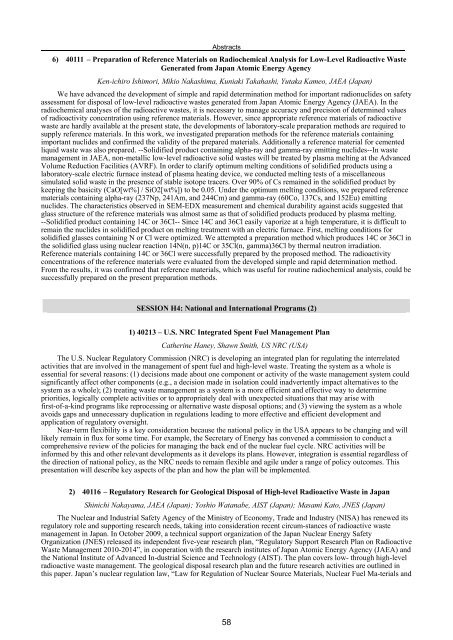The 13th International Conference on Environmental ... - Events
The 13th International Conference on Environmental ... - Events
The 13th International Conference on Environmental ... - Events
Create successful ePaper yourself
Turn your PDF publications into a flip-book with our unique Google optimized e-Paper software.
Abstracts<br />
6) 40111 – Preparati<strong>on</strong> of Reference Materials <strong>on</strong> Radiochemical Analysis for Low-Level Radioactive Waste<br />
Generated from Japan Atomic Energy Agency<br />
Ken-ichiro Ishimori, Mikio Nakashima, Kuniaki Takahashi, Yutaka Kameo, JAEA (Japan)<br />
We have advanced the development of simple and rapid determinati<strong>on</strong> method for important radi<strong>on</strong>uclides <strong>on</strong> safety<br />
assessment for disposal of low-level radioactive wastes generated from Japan Atomic Energy Agency (JAEA). In the<br />
radiochemical analyses of the radioactive wastes, it is necessary to manage accuracy and precisi<strong>on</strong> of determined values<br />
of radioactivity c<strong>on</strong>centrati<strong>on</strong> using reference materials. However, since appropriate reference materials of radioactive<br />
waste are hardly available at the present state, the developments of laboratory-scale preparati<strong>on</strong> methods are required to<br />
supply reference materials. In this work, we investigated preparati<strong>on</strong> methods for the reference materials c<strong>on</strong>taining<br />
important nuclides and c<strong>on</strong>firmed the validity of the prepared materials. Additi<strong>on</strong>ally a reference material for cemented<br />
liquid waste was also prepared. --Solidified product c<strong>on</strong>taining alpha-ray and gamma-ray emitting nuclides--In waste<br />
management in JAEA, n<strong>on</strong>-metallic low-level radioactive solid wastes will be treated by plasma melting at the Advanced<br />
Volume Reducti<strong>on</strong> Facilities (AVRF). In order to clarify optimum melting c<strong>on</strong>diti<strong>on</strong>s of solidified products using a<br />
laboratory-scale electric furnace instead of plasma heating device, we c<strong>on</strong>ducted melting tests of a miscellaneous<br />
simulated solid waste in the presence of stable isotope tracers. Over 90% of Cs remained in the solidified product by<br />
keeping the basicity (CaO[wt%] / SiO2[wt%]) to be 0.05. Under the optimum melting c<strong>on</strong>diti<strong>on</strong>s, we prepared reference<br />
materials c<strong>on</strong>taining alpha-ray (237Np, 241Am, and 244Cm) and gamma-ray (60Co, 137Cs, and 152Eu) emitting<br />
nuclides. <str<strong>on</strong>g>The</str<strong>on</strong>g> characteristics observed in SEM-EDX measurement and chemical durability against acids suggested that<br />
glass structure of the reference materials was almost same as that of solidified products produced by plasma melting.<br />
--Solidified product c<strong>on</strong>taining 14C or 36Cl-- Since 14C and 36Cl easily vaporize at a high temperature, it is difficult to<br />
remain the nuclides in solidified product <strong>on</strong> melting treatment with an electric furnace. First, melting c<strong>on</strong>diti<strong>on</strong>s for<br />
solidified glasses c<strong>on</strong>taining N or Cl were optimized. We attempted a preparati<strong>on</strong> method which produces 14C or 36Cl in<br />
the solidified glass using nuclear reacti<strong>on</strong> 14N(n, p)14C or 35Cl(n, gamma)36Cl by thermal neutr<strong>on</strong> irradiati<strong>on</strong>.<br />
Reference materials c<strong>on</strong>taining 14C or 36Cl were successfully prepared by the proposed method. <str<strong>on</strong>g>The</str<strong>on</strong>g> radioactivity<br />
c<strong>on</strong>centrati<strong>on</strong>s of the reference materials were evaluated from the developed simple and rapid determinati<strong>on</strong> method.<br />
From the results, it was c<strong>on</strong>firmed that reference materials, which was useful for routine radiochemical analysis, could be<br />
successfully prepared <strong>on</strong> the present preparati<strong>on</strong> methods.<br />
SESSION H4: Nati<strong>on</strong>al and <str<strong>on</strong>g>Internati<strong>on</strong>al</str<strong>on</strong>g> Programs (2)<br />
1) 40213 – U.S. NRC Integrated Spent Fuel Management Plan<br />
Catherine Haney, Shawn Smith, US NRC (USA)<br />
<str<strong>on</strong>g>The</str<strong>on</strong>g> U.S. Nuclear Regulatory Commissi<strong>on</strong> (NRC) is developing an integrated plan for regulating the interrelated<br />
activities that are involved in the management of spent fuel and high-level waste. Treating the system as a whole is<br />
essential for several reas<strong>on</strong>s: (1) decisi<strong>on</strong>s made about <strong>on</strong>e comp<strong>on</strong>ent or activity of the waste management system could<br />
significantly affect other comp<strong>on</strong>ents (e.g., a decisi<strong>on</strong> made in isolati<strong>on</strong> could inadvertently impact alternatives to the<br />
system as a whole); (2) treating waste management as a system is a more efficient and effective way to determine<br />
priorities, logically complete activities or to appropriately deal with unexpected situati<strong>on</strong>s that may arise with<br />
first-of-a-kind programs like reprocessing or alternative waste disposal opti<strong>on</strong>s; and (3) viewing the system as a whole<br />
avoids gaps and unnecessary duplicati<strong>on</strong> in regulati<strong>on</strong>s leading to more effective and efficient development and<br />
applicati<strong>on</strong> of regulatory oversight.<br />
Near-term flexibility is a key c<strong>on</strong>siderati<strong>on</strong> because the nati<strong>on</strong>al policy in the USA appears to be changing and will<br />
likely remain in flux for some time. For example, the Secretary of Energy has c<strong>on</strong>vened a commissi<strong>on</strong> to c<strong>on</strong>duct a<br />
comprehensive review of the policies for managing the back end of the nuclear fuel cycle. NRC activities will be<br />
informed by this and other relevant developments as it develops its plans. However, integrati<strong>on</strong> is essential regardless of<br />
the directi<strong>on</strong> of nati<strong>on</strong>al policy, as the NRC needs to remain flexible and agile under a range of policy outcomes. This<br />
presentati<strong>on</strong> will describe key aspects of the plan and how the plan will be implemented.<br />
2) 40116 – Regulatory Research for Geological Disposal of High-level Radioactive Waste in Japan<br />
Shinichi Nakayama, JAEA (Japan); Yoshio Watanabe, AIST (Japan); Masami Kato, JNES (Japan)<br />
<str<strong>on</strong>g>The</str<strong>on</strong>g> Nuclear and Industrial Safety Agency of the Ministry of Ec<strong>on</strong>omy, Trade and Industry (NISA) has renewed its<br />
regulatory role and supporting research needs, taking into c<strong>on</strong>siderati<strong>on</strong> recent circum-stances of radioactive waste<br />
management in Japan. In October 2009, a technical support organizati<strong>on</strong> of the Japan Nuclear Energy Safety<br />
Organizati<strong>on</strong> (JNES) released its independent five-year research plan, “Regulatory Support Research Plan <strong>on</strong> Radioactive<br />
Waste Management 2010-2014”, in cooperati<strong>on</strong> with the research institutes of Japan Atomic Energy Agency (JAEA) and<br />
the Nati<strong>on</strong>al Institute of Advanced In-dustrial Science and Technology (AIST). <str<strong>on</strong>g>The</str<strong>on</strong>g> plan covers low- through high-level<br />
radioactive waste management. <str<strong>on</strong>g>The</str<strong>on</strong>g> geological disposal research plan and the future research activities are outlined in<br />
this paper. Japan’s nuclear regulati<strong>on</strong> law, “Law for Regulati<strong>on</strong> of Nuclear Source Materials, Nuclear Fuel Ma-terials and<br />
58
















